|
|
|
Sort Order |
|
|
|
Items / Page
|
|
|
|
|
|
|
| Srl | Item |
| 1 |
ID:
181159
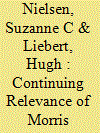

|
|
|
|
|
| Summary/Abstract |
In the current strategic environment, Morris Janowitz’s The Professional Soldier deserves renewed emphasis, especially from the military’s senior leaders who are responsible for the education and development of the country’s officer corps. Janowitz’s work is an especially valuable guide to the education of officers today because of his focus on the need for military officers to understand the political impact of military posture and military operations. The education of U.S. military officers to meet the country’s national security needs in the 21st century must go beyond Huntington’s formulation of expertise to an appreciation, in Janowitz’s terms, of “the political and social impact of the military establishment on international security affairs” across the spectrum of conflict. Janowitz’s formulation is the better guide because military means serve political purposes, and ultimately, a country’s strategic success will be judged in political terms.
|
|
|
|
|
|
|
|
|
|
|
|
|
|
|
|
| 2 |
ID:
181160


|
|
|
|
|
| Summary/Abstract |
Can foreign aid trigger ethnic war? The quantitative conflict literature has produced mixed findings on the effect of foreign aid on civil war in developing states. One reason for the mixed results is that a subset of civil wars, ethnic wars, are more likely than other kinds of civil wars to be triggered by foreign aid. This is because large amounts of foreign aid can cause the state to become a prize worth fighting over, mobilizing ethnic identity and group-related rebellion. This article investigates this question by testing the separate impacts of total, bilateral, and multilateral aid given by state and nonstate actors on the onset of ethnic war, using a cross-national time-series dataset of 147 countries from 1961 to 2008. The findings show a very strong association of foreign aid with ethnic war, whether measured as total aid, bilateral aid, or multilateral aid.
|
|
|
|
|
|
|
|
|
|
|
|
|
|
|
|
| 3 |
ID:
181153
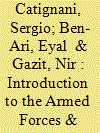

|
|
|
|
|
| Summary/Abstract |
This Armed Forces & Society forum is dedicated to exploring recent trends in the characteristics of military reserves and of the changing character of reserve forces within the armed forces within the military, the civilian sphere, and in between them. To bring new and critical perspectives to the study of reserve forces and civil–military relations, this introduction and the five articles that follow draw on two organizing conceptual models: The first portrays reservists as transmigrants and focuses on the plural membership of reservists in the military and in civilian society and the “travel” between them. The second model focuses on the multiple formal and informal compacts (contracts, agreements, or pacts) between reservists and the military.
|
|
|
|
|
|
|
|
|
|
|
|
|
|
|
|
| 4 |
ID:
181158
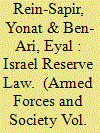

|
|
|
|
|
| Summary/Abstract |
Enacted in 2008, 60 years after Israel Defense Forces was established, the Israeli Reserves Law is a striking expression of the decline of military autonomy in a democratic country. While not aimed at reducing the military’s discretion in regard to the training, deployment, and compensation for reservists, the formal enactment of the Law in effect did so. The legislative process was preceded by a crisis between reservists and the military and was led by several reservists’ organizations who tried to improve the standing and resources allocated to the reserve forces. The article analyzes the impact of these organizations and the coalitions they created with politicians serving in the national parliament, the Knesset. By choosing the legislative option to improve the conditions of service for reservists, they de facto reduced military autonomy since the new Law mandated supervision and monitoring (by civilian institutions) of the service of reservists and extended into the core area of military action, the operational use of force. Thus, the actions of reservists’ organizations turned a bilateral tie between the military and its (reserve) soldiers into a trilateral one, comprising the military, reserve soldiers, and state institutions.
|
|
|
|
|
|
|
|
|
|
|
|
|
|
|
|
| 5 |
ID:
181157
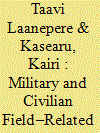

|
|
|
|
|
| Summary/Abstract |
The military service readiness of reserve soldiers is an essential question for countries that rely mostly on reserve units for their defense or other operational needs. This study examines how forms of capital related to the military and civilian fields are associated with the military service readiness of reservists. Survey data were obtained from 396 Estonian reservists during the 2018 Hedgehog exercise. Reservists’ military service readiness (RMSR) was studied first with respect to military field–related factors, and in the next phase civilian field linked factors are included. In a military field, cultural, social, and symbolic capital have a positive influence on RMSR. However, if civilian field–related social and economic capital is included, some military capitals would lose their effect. Study outcomes are discussed considering Pierre Bourdieu’s theory of the forms of capital.
|
|
|
|
|
|
|
|
|
|
|
|
|
|
|
|
| 6 |
ID:
181154


|
|
|
|
|
| Summary/Abstract |
This article reexamines and develops the analytical metaphor of “Reserve Soldiers as Transmigrants” in three directions. First, we advance the notion of transmigration by linking it to the explicit and implicit “contracts” or agreements struck between the military and individuals and groups within and outside of it. Second, we show that the “management” model of reserve forces is not just an administrative matter but that “negotiating” with reservists involves wider issues that include managing identity, commitment, and the meaning attached to military service. Third, we examine the institutional and political meaning of the reserves at the macro sociological level. The juxtaposition and interplay of two models—transmigration and multiple contracts—allows us to introduce structural elements into the movement of soldiers between the military and civilian society, and add a dynamic dimension to the contents of the implicit contracts that organize reservists’ relations with the state and military.
|
|
|
|
|
|
|
|
|
|
|
|
|
|
|
|
| 7 |
ID:
181155
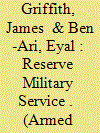

|
|
|
|
|
| Summary/Abstract |
This study examines reserve military service from a perspective of social construction—the ways in which the reservist’s conscious experiences are constructed to give meaning to military service. Content descriptions of conscious experiences of reserve military service are identified in past studies. Constructions fell into four broad categories: (1) complementary to life—reserve military service providing wanted satisfaction not otherwise achieved, material gain, or ideological commitment; (2) equitable arrangement—understood compensation for self-sacrifice; (3) discordant identity—requirements of military life blatantly or surreptitiously conflicting with established identity and civilian life; and (4) self-definition—reserve military service understood as an aspect of self-identity. Directions for integrating these constructions as a basis for future research are identified and discussed.
|
|
|
|
|
|
|
|
|
|
|
|
|
|
|
|
| 8 |
ID:
181156
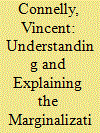

|
|
|
|
|
| Summary/Abstract |
Recent changes in the British Army mean part-time reservists and full-time regulars need to become better integrated. However, there has been a long history of workplace tensions between the full-time and part-time elements in the British Army. This mirrors those found in many civilian workplaces. Focus group data with 105 full-time regular British Army soldiers confirmed that time and emotional commitment are strongly linked in a full-time professional workplace that has strong, definite, and enduring boundaries. This, alongside demands for conformity and stratification by rank explained the high risk of marginalization of part-time reservists. The legitimacy of part-time reservists, especially in the combat arms, was often challenged. Using this explanatory framework, some implications and practical ways that tensions may be reduced between full-time and part-time members of the British Army, and other armed forces facing similar tensions, were highlighted.
|
|
|
|
|
|
|
|
|
|
|
|
|
|
|
|
|
|
|
|
|